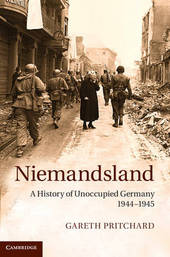
|
Niemandsland: A History of Unoccupied Germany, 1944-1945
Hardback
Main Details
| Title |
Niemandsland: A History of Unoccupied Germany, 1944-1945
|
| Authors and Contributors |
By (author) Gareth Pritchard
|
| Physical Properties |
| Format:Hardback | | Pages:264 | | Dimensions(mm): Height 235,Width 155 |
|
| ISBN/Barcode |
9781107013506
|
| Classifications | Dewey:943.086 |
|---|
| Audience | | Postgraduate, Research & Scholarly | |
|---|
| Illustrations |
2 Maps
|
|
Publishing Details |
| Publisher |
Cambridge University Press
|
| Imprint |
Cambridge University Press
|
| Publication Date |
29 March 2012 |
| Publication Country |
United Kingdom
|
Description
Niemandsland is the untold story of the largest and most enduring of the unoccupied enclaves that survived after Germany's invasion and occupation by Allied forces in 1945. Sandwiched between American and Red Army lines, the 500,000 inhabitants were cut off from the outside world and left to fend for themselves in the face of crippling shortages of food, fuel and housing. Gareth Pritchard charts how groups of Communists, Socialists and antifascists came together to form 'antifascist' committees which seized power and set about restoring order, ensuring the supply of food and essential services and hunting down, disarming and arresting fugitive Nazis. This is not only a fascinating history in its own right but it also sheds important new light on the fate of Germany after 1945. Only in Niemandsland do we see what happened when the currents of post-Nazi German politics were allowed to flow freely, unimpeded by Allied intervention.
Author Biography
Gareth Pritchard is Lecturer in Modern History at the University of Adelaide. His previous publications include The Making of the GDR (2004) and, as co-editor, Power and the People: A Social History of Central European Politics, 1945-56 (2005).
Reviews'Niemandsland is a model of local political history writing, offers new views on older debates, and will be of interest to historians of the immediate postwar era in Germany and in Europe more generally as well as to scholars of the Cold War.' Monica Black, The Journal of Modern History
|